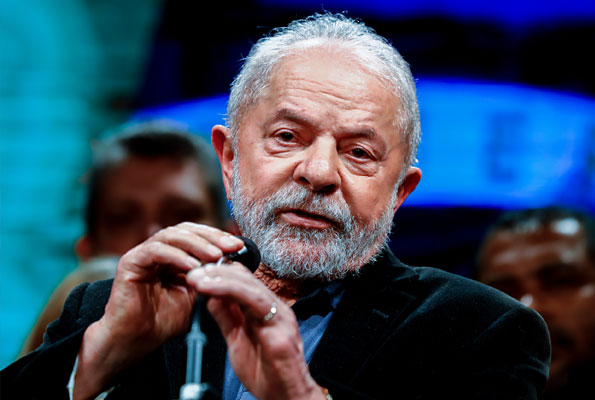With the return of Luiz Inacio Lula da Silva to office as Brazil’s new President, the country has a chance to correct the wrongs of the previous four years under Jair Bolsonaro and restore the nation on the path of equity-oriented growth. The socialist Workers’ Party leader known as Lula has a reputation for excellence and popularity. His first two administrations, which spanned the years 2003 to 2011, used a mixed economic strategy that combined market-friendly policies with substantial social spending. This approach enabled around 25 million Brazilians to escape poverty while simultaneously fostering rapid economic growth. However, years of difficulty ensued.
Lula’s hand-picked successor, the former revolutionary Dilma Rousseff, was impeached by a hostile Congress. The story of Brazil’s economic prosperity vanished under Jair Bolsonaro, the far-right, ultra-nationalist President who supports the country’s terrible military dictatorship, while hunger rose and its healthcare system disintegrated. At least 7,00,000 people died due to COVID-19 as the President downplayed the threat of the pandemic and his administration botched up its crisis response. Due to the initiatives are taken by Jair Bolsonaro the Amazon rainforests have been rapidly deforested.
During the Bolsonaro administration, Lula, who had been found guilty of corruption before being exonerated by the Supreme Court, was supported by Brazil’s liberal, working-class, and progressive groups. Lula, who departed office in 2011 with an approval rating of 83%, mobilized the opposition, helping them win the presidential run-off by a small but resounding margin. Lula said that he will put an emphasis on peace and rebuilding. To his advantage, a new pink tide is sweeping through South America. Leaders on the left in nations like Venezuela and Chile will embrace his programme. As he intends to spend an additional USD 28 billion this year, Lula has already succeeded in getting a constitutional amendment passed that suspends Brazil’s expenditure cap.
Many political experts say the journey would not be easy for Lula. One such example is the protest that happened just after the inauguration where Jair Bolsonaro fled Brazil, and his supporters violently protested, urging the military to “shut down the government.” The challenges facing the economy will be worse if social tensions remain high. The commodity boom that helped fund Lula’s social welfare spending in the early 2000s is non-existent today. Experts say he needs to unify a divided nation, and rebuild the economy, the healthcare system, and the public’s confidence in the government. Lula should move gradually, engaging in negotiations with the various factions of Brazil’s aristocracy-dominated political system, and working for modest but significant improvements in the country’s wealth distribution.
Precarious economic footing
Jair Bolsonaro increased cash handouts and capped gasoline and energy taxes at the end of his term, which increased Brazil’s debt load. The nation’s debt-to-GDP ratio is currently close to 90%. High debt loads have higher interest costs, which reduces government spending on items like healthcare and education. Undoubtedly, inflation has decreased recently but Brazil’s economic situation is very fragile. Lula’s Workers Party (PT) has already hinted at maintaining the recently approved boost to social welfare.
Nelson Barbosa, Brazil’s minister of finance from 2015-16, said the boost to social welfare won’t last forever. “Assuming growth rebounds towards the end of next year, support measures will have to be rolled back. That said, the focus will be on stimulating growth and then reducing debt”, Nelson Barbosa added.
PT economists have voiced concerns about Brazil’s present fiscal regulations in light of Lula’s emphasis on public investment. The government’s expenditure cap, which restricts budget increases to inflation, has received particularly harsh criticism.
“This fiscal protocol is not fit for purpose. It should be replaced by a new rule which allows spending to grow in real terms and is based on a long-term fiscal scenario for public debt,” Barbosa said.
The convoluted tax structure in Brazil has to be simplified, according to the PT. Some observers predict that Lula would keep some of Jair Bolsonaro’s policy recommendations, like the consolidation of regional sales taxes into a single national value-added tax. In other places, PT is rumoured to be proposing a more progressive tax system that would increase exemptions for people with low incomes. Aside from the state of the economy, the PT earlier promised to undo Brazil’s 2017 labour reform law, which reduced the bargaining power of employees. However, the party has softened its position in recent months.
According to Marcos Casarin, Chief Economist for Latin America at Oxford Economics, Lula may try and adjust the bill by reintroducing mandatory funding for unions. He may also try to raise the minimum wage, but that would cost him politically.
During the election campaign, other talking points included increased pay for ‘gig’ workers. COVID-19 exacerbated socioeconomic vulnerabilities in Brazil’s sizable informal economy, which accounts for 40% of the country’s employed workforce. To assist these workers, Mr Marcos pointed out that “a tax indexed to app companies’ revenue could be explored”, but stressed that, “while these measures would provide a fiscal lift, they are not a priority for Congress”.
Treacherous terrain
The far-right consolidated its control over the National Congress of the country in the first-round elections on October 2. All deputies in the house and one-third of senators were reappointed by voters. In the former, Jair Bolsonaro’s PL won 99 seats, making up the largest single-party bloc. PL and its right-wing allies won 19 of the 27 seats up for grabs in the latter. In the upcoming years, it is now widely anticipated that Bolsonaro-supporting parliamentary forces will try to stymie PT’s programme.
“The terrain is very treacherous for any political leader…passing economic reforms will be an uphill battle,” noted Alfredo Saad-Filho, professor of international development at King’s College London. Lula’s politics, in turn, may be forced to shift more to the centre.
“Lula is arguably the most talented politician of his generation and if anyone can heal the country’s fissures it’s him. But given the political landscape, he will have to make big concessions over the next four years. I’m not optimistic about progressive reform,” Saad-Filho added.
So far the financial markets have been optimistic about Lula’s return. Fernando Haddad, Brazil’s new finance minister, allayed market fears by downplaying the possibility of excessive state spending. In opposition to Jair Bolsonaro, Lula was compelled to establish a sizable political church at the same time. This, together with vehement parliamentary resistance, will probably be reflected in an economic policy that is moderate.
The result is that Lula won’t be able to benefit from a growth spike that occurred in the 2000s. Additionally, he is coming under increasing pressure to decarbonize Brazil’s economic strategy and reassert greater government control over Petrobras, the state-owned energy corporation. In other words, he has enormous challenges coming ahead.
Brazil’s economy at risk?
Despite favourable demographic trends, structural limitations in Brazil’s economy over the past ten years have resulted in a meagre GDP growth of 0.3%. Ineffective sectoral state intervention policies, a complex tax system, a burdensome business environment, slow human capital accumulation, low savings, and compression of public investment to accommodate rising current spending and rising pension obligations are all contributing factors to the weak productivity growth.
Brazil suffered one of the greatest mortality rates worldwide as a result of the COVID-19 pandemic, but since the middle of 2021, a quick vaccination programme has helped things get back to normal. In Brazil, 86.8% of the populace had received the first dosage of the vaccine as of September 2022, and 79.4% of people had completed the initial immunisation schedule.
The economy recovered in 2021 (+4.6% y/y) on the strength of the services sector following a pandemic-induced recession in 2020 (-3.9% y/y). The substantial counter-cyclical fiscal reaction adopted in 2020 through social protection programmes lessened the pandemic’s impact on poverty, but it also increased the reliance of households on public transfers, increased the primary deficit, and increased the Gross Debt of the Government. Although Brazil’s labour market is showing strong signs of recovery, with the unemployment rate hitting 8.9% as of September 2022, the unequal labour market impacts reinforced pre-existing vulnerability profiles as bigger job losses were concentrated in low-skilled and highly insecure jobs.
Significant negative risks still exist in 2023 due to the high level of uncertainty. The global economic backdrop further weighed on Brazil’s recovery, including inflation and rising policy rates—both in Brazil and in the world—and supply bottlenecks related to the ongoing war in Ukraine, causing commodities prices to soar and thus further reinforcing the inflation pressures. Additionally, concerns remain about anaemic potential growth and slow policy reform continues. Even though the continued fiscal consolidation accomplished throughout 2022, Brazil’s most pressing economic concern continues to be restoring fiscal sustainability.
The substantial decline in poverty and inequality rates starting in 2020 was just temporary. Employment levels, labour force participation rates and the proportion of formally employed people all declined in 2021 compared to 2019. In the final quarter of 2021, unemployment rates reached their pre-pandemic levels, but they are still high. Higher poverty rates could result if labour income is unable to fully offset the drop in government handouts. Fewer employment prospects and a slower return to the workforce have made female workers and households headed by women more vulnerable.
In order to reduce poverty from 26.2% in 2019 to 18.7% in 2020 (based on the USD 6.85/day PPP level), the government provided quick and generous temporary relief. But in 2023, poverty is projected to rise to 28.4% of the population. Even though a new round of Auxiliary Emergency Income Support was granted and extended till December 2022, the benefits were lower and the covered population was smaller. In addition to a sluggish labour market recovery and rising costs, particularly for food, the real worth of the income of those at the bottom of the distribution fell dramatically.
A significant policy problem in the years to come will be striking the correct balance between safeguarding the poor and ensuring sustainable public finances, notably at subnational levels. Supporting the switch to a more sustainable and resilient growth model continues to be a major challenge. More than 60% of the Amazon rainforest, the largest tropical forest in the world, is found in Brazil, which also has a high share of renewable energy sources in its energy mix. However, Brazil has not created an integrated long-term national strategy to accomplish its climate goals. The country’s NDC targets (a decrease in GHG emissions of 37% by 2025 and 43% by 2030) are not being met due to the rise in deforestation emissions.



